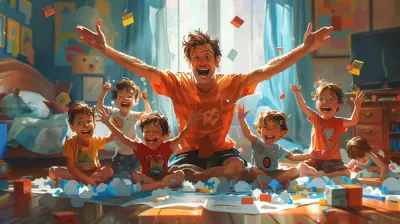How to Introduce Your Kids to Coding Without Overwhelming Them
21 June 2025
If you’ve ever watched your kid fiddle with a tablet and thought, “Whoa, they’re better at this than I am,” you’re not alone. Our kids are growing up in a digital world where screens aren’t just entertainment—they’re tools, classrooms, and playgrounds. And guess what? Coding is the language behind most of it. The good news? You don’t need to be a tech expert to introduce your child to coding. The even better news? You can help them fall in love with it—without pushing them too hard or turning it into another boring chore.
In this article, we’re diving deep into how to introduce your kids to coding without overwhelming them. We’ll keep it light, fun, and entirely doable—even if the only code you’ve ever written is your Wi-Fi password.
Why Start Coding Young?
First off, why is everyone suddenly obsessed with teaching kids to code? Is it really that big of a deal?In short—yes. Coding teaches kids way more than just how to type funky symbols on a screen. It’s about problem-solving, critical thinking, creativity, and resilience. When kids learn to code, they’re learning how to think. They’re also building a skill set that’s becoming more valuable every single year.
That said, kids don’t need to become mini software engineers overnight. The goal isn’t to raise child prodigies—it’s to open the door to an exciting world, without pressure.
Keep It Fun: Play Is the Secret Ingredient
You know what kids don’t want? Another lecture. Coding shouldn’t feel like homework. Instead, it should feel like play—which is actually how kids learn best.Use Games That Teach Coding Skills
There are loads of awesome games out there that sneak in coding concepts while kids think they’re just having fun. A few faves:- ScratchJr (Ages 5-7): Kids snap together code blocks like puzzle pieces to bring stories and characters to life.
- Blockly Games (Ages 8+): A visual programming game that gradually introduces more complex logic.
- Minecraft: Education Edition: Yep, that’s right—your kid’s obsession with Minecraft can actually teach them coding (through add-ons and mods).
These tools are colorful, interactive, and designed specifically to make the learning curve feel like a ramp, not a cliff.
Start With the Basics (No Computer Required)
You don’t even need a device to start teaching coding concepts. Sounds weird, right? But here’s the deal—coding is just instructions in a logical sequence. That’s something kids already know how to do.Try Unplugged Activities
Here are a few “offline” activities to get your child’s brain into coding mode:- Treasure Hunt Maps: Let your child “code” a path for you to follow. They write instructions like, “Go forward 3 steps, turn right, take 2 steps.”
- Cooking Together: Recipes are just algorithms in disguise—step-by-step instructions to reach a goal.
- Lego Builds: Following instructions to build something out of tiny bricks? Yep, that’s coding logic at work.
You’re introducing the mindset of sequencing, testing, and learning from mistakes—all without a screen.
Let Curiosity Lead the Way
Imagine you’re walking into a candy store. Someone shoves a bag of jellybeans in your hand and says, “Eat this now.” You’d probably back away, right?Now imagine you explore the shelves, pick out something colorful, and take a bite because you want to. That’s what learning should feel like—especially coding.
Follow Your Kid’s Interests
If your child loves stories, introduce them to coding through storytelling apps. If they’re into robots, build one together that they can program. Obsessed with video games? Talk about how games are made and encourage them to design their own.This keeps the experience personal and exciting—and way less overwhelming.
Keep Goals Tiny and Celebrations Big
One of the fastest ways to kill excitement is by setting the bar too high too soon. Coding is a skill that builds over time, like learning to read or ride a bike.Break It Down Into Bite-Sized Wins
Instead of jumping into full apps or projects, start with mini-goals like:- Making a character move across the screen
- Creating a simple animation
- Building a short game level
Each of these small wins adds up. And every time they achieve one, celebrate it! High-fives, praise, stickers, or even a coding badge chart—whatever makes your child feel like a rockstar.
Be a Co-Learner, Not Just a Teacher
Here’s a little secret: You don’t have to know everything. In fact, saying “Let’s figure this out together” is one of the most empowering things a parent can do.Learn Alongside Your Child
When you approach coding as a team activity, it changes the whole vibe. Instead of being the one in charge, you’re both adventurers discovering a new world.Ask questions out loud. Make mistakes. Laugh about bugs. Your child will see that learning is about trying, failing, and trying again—which is exactly what coding is about.
Avoid the Pressure Trap
It’s easy to fall into the “my-kid-needs-to-be-a-genius” mindset, especially when you see other kids building apps or winning coding contests. But remember—coding is a journey, not a competition.Pace Matters More Than Progress
Every child moves at their own speed. Some might be ready to dive into Python by age 10, while others may prefer visual coding until high school. Both paths are fine. The key is to stay supportive and encouraging without comparing or criticizing.If they lose interest for a while? That’s okay too. The goal is exposure and enjoyment—not perfection.
Use Real-World Examples That Stick
Kids often ask, “Why do I need to know this?” With coding, the answer is everywhere.Show How Coding Touches Their World
Point out the role of coding in things your child loves:- Their favorite video games? Built by coders.
- That YouTube video they keep watching? Editing software relies on code.
- The cool robot vacuum zooming around? Runs on a program.
When kids understand that coding isn’t some abstract, boring skill—but something that powers the world around them—it suddenly feels relevant and exciting.
Invest in the Right Tools (Without Breaking the Bank)
You don’t need to spend thousands on fancy tech to get your child started.Start Simple
A basic laptop or tablet will work just fine with most beginner platforms. Lots of resources, like Scratch or Code.org, are totally free. Want to level up later on? There are tons of reasonably priced kits and coding toys that add some fun:- Ozobot
- Kano Computer Kits
- Sphero Mini Robots
But again—it’s not about the tools. It’s about the experience and your involvement.
Encourage Storytelling Through Code
This one’s a game-changer, especially for kids who love writing or art.Code as a Creative Outlet
Let your child use code to create:- Interactive stories
- Digital greeting cards
- Animated comic strips
Platforms like Tynker and Scratch let kids drag-and-drop blocks to bring their ideas to life. When coding becomes a form of self-expression, it becomes inherently motivating.
Stick With It (Even When It’s Hard)
Yes, coding can get frustrating. There will be bugs, errors, and moments that make your kid want to throw their device out the window. Totally normal.Teach a Growth Mindset
Use those tough moments to show the real magic of coding: persistence. Remind them that every error is just a puzzle waiting to be solved. Encourage them to take breaks, try again, and celebrate effort—not just outcomes.You’re planting the seeds of resilience—not just in coding, but in life.
Don’t Just Code—Create!
Once your child gets the hang of coding basics, encourage them to make things they care about. That could be:- Designing a simple game for their friend
- Making a digital birthday card for Grandma
- Creating a mini website about their pet
When coding becomes a tool for creativity, it loses its “scary tech” vibe and becomes something kids love doing.
Final Thoughts: You’ve Got This
You don’t need a computer science degree. You don’t even need to know how to code yourself. All you need is a willingness to explore, experiment, and cheer your child on.Introduce coding the same way you taught your kid to ride a bike or bake cookies—via joy, curiosity, and support. Let it be an adventure you take together. With patience and play at the heart of it, your child can unlock an incredible new world, one line of code at a time.
all images in this post were generated using AI tools
Category:
Tech And KidsAuthor:

Steven McLain
Discussion
rate this article
2 comments
Ziva Wood
Start with play-based learning to spark curiosity. Incorporate fun, relatable projects that align with their interests, fostering a love for coding without pressure. Small, consistent steps can ignite lasting passion.
October 30, 2025 at 5:36 PM

Steven McLain
Absolutely! Play-based learning is a fantastic way to engage kids with coding. By making it fun and relatable, we can inspire their curiosity and passion without the pressure. Small, enjoyable projects will keep them motivated!
Lucy Beck
Spark curiosity, let them play, and watch their creativity soar!
June 25, 2025 at 3:13 AM

Steven McLain
Absolutely! Encouraging exploration and play is key to fostering creativity in coding. Letting kids engage freely can spark their interest and make learning enjoyable!


